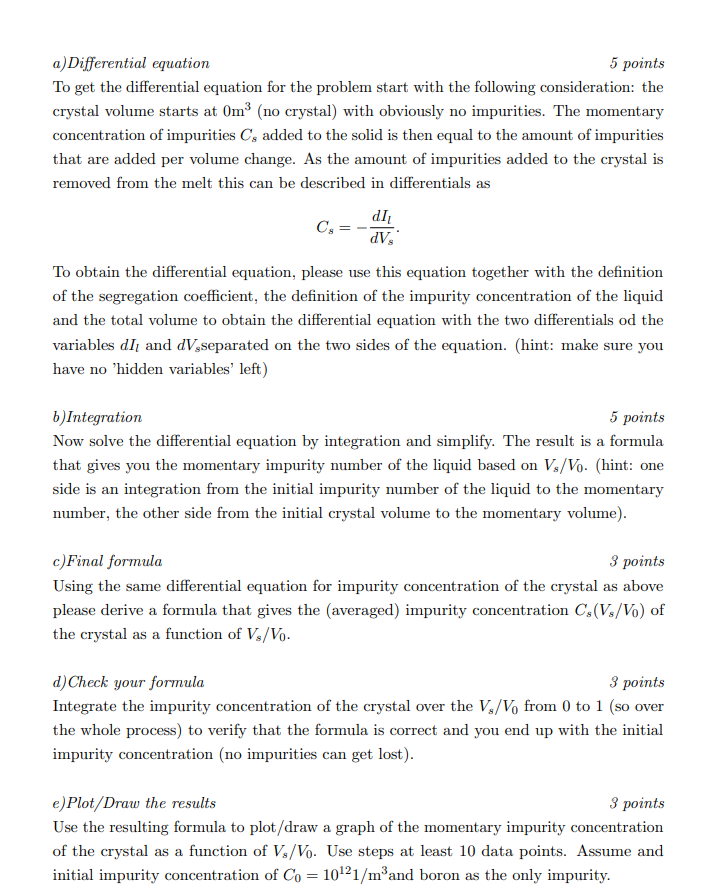I cant figure out how to set up this problem and what I need to solve for. We are also given that K0 = Cs/Ci. This is the segregation coef. Please help :)


a) Differential equation 5 points To get the differential equation for the problem start with the following consideration: the crystal volume starts at 0m3 (no crystal) with obviously no impurities. The momentary concentration of impurities Cs added to the solid is then equal to the amount of impurities that are added per volume change. As the amount of impurities added to the crystal is removed from the melt this can be described in differentials as C. = dI dV To obtain the differential equation, please use this equation together with the definition of the segregation coefficient, the definition of the impurity concentration of the liquid and the total volume to obtain the differential equation with the two differentials od the variables dI and dV separated on the two sides of the equation. (hint: make sure you have no 'hidden variables' left) b) Integration 5 points Now solve the differential equation by integration and simplify. The result is a formula that gives you the momentary impurity number of the liquid based on Vs/V. (hint: one side is an integration from the initial impurity number of the liquid to the momentary number, the other side from the initial crystal volume to the momentary volume). c)Final formula 3 points Using the same differential equation for impurity concentration of the crystal as above please derive a formula that gives the averaged) impurity concentration Cs(V/V) of the crystal as a function of Vs/V. d) Check your formula 3 points Integrate the impurity concentration of the crystal over the V/V, from 0 to 1 (so over the whole process) to verify that the formula is correct and you end up with the initial impurity concentration (no impurities can get lost). e) Plot/Draw the results 3 points Use the resulting formula to plot/draw a graph of the momentary impurity concentration of the crystal as a function of V:/V. Use steps at least 10 data points. Assume and initial impurity concentration of Co = 10121/mand boron as the only impurity. f) Stop condition 1 point At which point of this process would you need to stop it if you wanted to have a maximum impurity concentration Cmax = 10121/m in any part of the ingot? (Same assumptions as in the previous task) a) Differential equation 5 points To get the differential equation for the problem start with the following consideration: the crystal volume starts at 0m3 (no crystal) with obviously no impurities. The momentary concentration of impurities Cs added to the solid is then equal to the amount of impurities that are added per volume change. As the amount of impurities added to the crystal is removed from the melt this can be described in differentials as C. = dI dV To obtain the differential equation, please use this equation together with the definition of the segregation coefficient, the definition of the impurity concentration of the liquid and the total volume to obtain the differential equation with the two differentials od the variables dI and dV separated on the two sides of the equation. (hint: make sure you have no 'hidden variables' left) b) Integration 5 points Now solve the differential equation by integration and simplify. The result is a formula that gives you the momentary impurity number of the liquid based on Vs/V. (hint: one side is an integration from the initial impurity number of the liquid to the momentary number, the other side from the initial crystal volume to the momentary volume). c)Final formula 3 points Using the same differential equation for impurity concentration of the crystal as above please derive a formula that gives the averaged) impurity concentration Cs(V/V) of the crystal as a function of Vs/V. d) Check your formula 3 points Integrate the impurity concentration of the crystal over the V/V, from 0 to 1 (so over the whole process) to verify that the formula is correct and you end up with the initial impurity concentration (no impurities can get lost). e) Plot/Draw the results 3 points Use the resulting formula to plot/draw a graph of the momentary impurity concentration of the crystal as a function of V:/V. Use steps at least 10 data points. Assume and initial impurity concentration of Co = 10121/mand boron as the only impurity. f) Stop condition 1 point At which point of this process would you need to stop it if you wanted to have a maximum impurity concentration Cmax = 10121/m in any part of the ingot? (Same assumptions as in the previous task)








